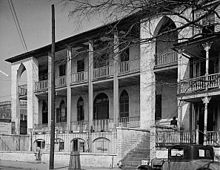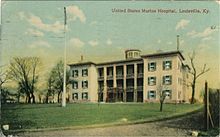Marine Hospital Service: Difference between revisions
→History: reorganization was formalized in June 1870 |
Rescuing 1 sources and tagging 0 as dead. #IABot (v1.4beta) |
||
| Line 28: | Line 28: | ||
{{Commons category|United States Marine Hospitals}} |
{{Commons category|United States Marine Hospitals}} |
||
* The National Library of Medicine has a [http://www.nlm.nih.gov/hmd/manuscripts/ead/phs471.html guide] to the documents culled from various PHS hospitals when these closed. |
* The National Library of Medicine has a [https://web.archive.org/web/20041010204116/http://www.nlm.nih.gov/hmd/manuscripts/ead/phs471.html guide] to the documents culled from various PHS hospitals when these closed. |
||
* [http://marinehospital.org marinehospital.org]- Website of the U.S. Hospital Foundation, which is restoring the Marine Hospital in [[Louisville, Kentucky]]. |
* [http://marinehospital.org marinehospital.org]- Website of the U.S. Hospital Foundation, which is restoring the Marine Hospital in [[Louisville, Kentucky]]. |
||
Revision as of 21:06, 2 June 2017


The Marine-Hospital Service was an organization of Marine Hospitals dedicated to the care of ill and disabled seamen in the U.S. Merchant Marine, U.S. Coast Guard and other federal beneficiaries.
History


The Service was created by the act of the 5th United States Congress, which was signed into law on 16 July 1798 by President John Adams. The Act required the Department of the Treasury to "provide for the relief and maintenance of disabled seamen." This Act led to the formation of several loosely controlled hospitals at sea and river ports all across the United States, which was officially the Marine-Hospital Fund. The Act specified the revenue for the Hospital Fund to come from the merchant seamen. The Congressional Act of 1798 was signed into law by President John Adams. It created a tax of 20 cents each month to be withheld from seamen’s wages for support of marine hospitals. The money was paid to the U.S. Collector of Customs. The Act was expanded in 1799 to include all "officers, seamen and marines of the navy of the United States". This practice continued until 1870, excepting one year from April 1837 to 1838. This series of hospitals to care for merchant seamen was based on the British practice of establishing hospitals to care for sailors and merchant seamen. Prior to its union with Scotland, the Kingdom of England established its first hospitals in 1588, shortly after its victory over the Spanish Armada. The Marine Hospital Fund was a unique and early mechanism to provide the first publicly funded health care and disease prevention federal agency in the United States.
Following the Civil War, public outcry and scandal surrounded the Marine Hospital Fund. In 1869, Dr. John Shaw Billings, a prominent Army surgeon, was appointed to head an investigation of the Marine Hospital Fund. Dr. Billings found the hospital fund to be inadequate and completely unorganized. In June 1870 the 41st Congress formally reorganized the Marine Hospital Fund as the Marine Hospital Service. Dr. John Maynard Woodworth was subsequently appointed to the Service as "Supervising Surgeon." He transformed the service into a disciplined organization based on his experience in the Union Army as a surgeon. Dr. Woodworth required his physicians to be a mobile work force stationed where the service was in need, and he mandated the daily wear uniforms. This eventually led to the creation of the modern-day Public Health Service Commissioned Corps. Dr. Woodworth, using Army-style heraldry, created the Marine Hospital Service fouled anchor and caduceus seal which is used to this day by the Public Health Service. In 1873, Dr. Woodworth’s title was changed to "Supervising Surgeon General," a forerunner of the modern-day office of Surgeon General of the United States.


It was the point of origin for the Public Health Service and the Public Health Service Commissioned Corps of the present-day Department of Health and Human Services, and current Operating Divisions (OPDIV) and Staffing Divisions that include the National Institutes of Health, the Centers for Disease Control and Prevention, Indian Health Service, and a host of other federal-level health programs. The Marine Hospitals, as their name suggests, were hospitals constructed at key sea and river ports across the nation to provide health care for merchant marine sailors. Aside from the well-being of these sailors, the hospitals provided a key monitoring and gate-keeping function against pathogenic diseases.
As the nation grew, the scope of Marine Hospital Service's scope of duties grew to include domestic and foreign quarantine and other national public health functions. In 1902, the Marine Hospital Service was renamed the "Public Health and Marine-Hospital Service." In 1912, the name of the service was changed to the Public Health Service to encompass its diverse and changing mission. Over time, the hospitals of the service were also expanded to include research and prevention work as well as the care of patients. Aside from merchant seamen, members of the military, immigrants, Native Americans, other federal beneficiaries, and people affected by chronic and epidemic diseases found a source for health care in the PHS and its hospitals.
The hospitals themselves were, by the middle of the 19th century, fairly imposing and architecturally grand structures in many cases. As long as ample federal funding was available for their construction, these hospitals were impressive examples of government-provided health care. The hospitals of the early 20th century in major port cities such as New Orleans, San Francisco, and Savannah displayed ornate architectural detail and reflected many of the changes sweeping medicine at the time.
During the Nixon administration, funding was cut to the PHS hospitals program and many of these institutions closed or were turned over to local public health offices. Eight survived as federal institutions until the early 1980s, when further budget cuts put an end to their funding. Some, such as the one in Savannah, Georgia, continued as outpatient low-income health clinics up to 2003 while others, such as the large hospital in San Francisco on the grounds of the US Army Presidio, were diverted to other Federal and military uses. In the case of the Presidio, the PHS Hospital was used as a site for language training for military officers in the late 1980s.
Today, the records for these institutions sit in storage at the National Library of Medicine in Bethesda, Maryland and the National Archives in College Park, Maryland.
See also
External links
- The National Library of Medicine has a guide to the documents culled from various PHS hospitals when these closed.
- marinehospital.org- Website of the U.S. Hospital Foundation, which is restoring the Marine Hospital in Louisville, Kentucky.
- History Of National Institution Of Health [1]
